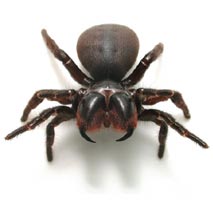
Mouse Spider
Missulena bradleyi
Family: Actinopodidae ID: Rainbow, 1914

Habitat and Biology
Like the trap-door spiders, the mouse spider lives in tunnels in the ground.
Unlike the Stanwellia trap-door spiders, mouse spiders do possess a `trap-door'
lid at the entrance. Males are most active during the daylight hours of the
early winter, when they search for a mate. A close relative, Missulena occatoria
Walckenaer, occurs in the drier western areas of Victoria and males of this
species have a distinctive red cephalothorax and black abdomen. The spiderlings
of the mouse spider apparently disperse on gossamer, a technique which is rare
in mygalomorphs. The common name derives from the erroneous belief that this
spider excavated a mouse-like burrow.
Colour
Male: Cephalothorax and legs glossy black, abdomen slightly paler with distinct
pale bluish patch on upperside towards the front.
Female: Dark brown to blackish.
Form
Recognised by the large cephalothorax, stout legs, and eye formation spread
across the front of the cephalothorax instead of in a compact group as in trap-door
spiders.
Body Length
Male: 15mm
Female: 25mm
Web type
Does not build a web.
Bite
Although some experimental
evidence suggests the venom of mouse spiders is relatively toxic, most recorded
bites have not produced serious reactions.